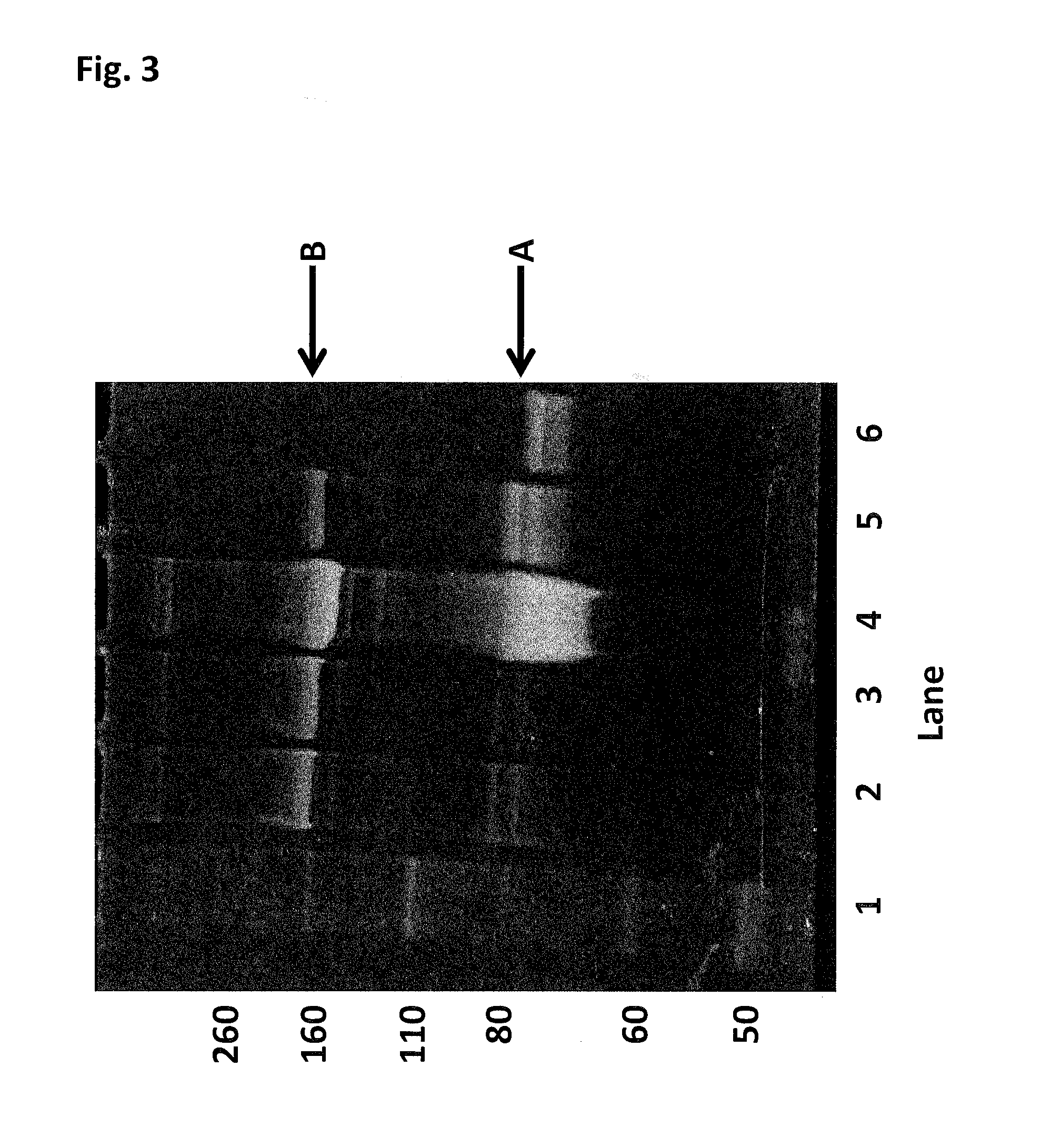Enzyme construct
- Summary
- Abstract
- Description
- Claims
- Application Information
AI Technical Summary
Benefits of technology
Problems solved by technology
Method used
Image
Examples
example 1
[0418]In this Example and all of the following Examples, bismaleimide-functionalized PEG linkers are identified with reference to their molecular weight. For instance, “2 kDa”, “2 kDA linker” or “2 kDA PEG linker” refers to a bismaleimide-functionalized PEG linker having a molecular weight of 2 kDa.
[0419]This Example describes the method of synthesising the Hel308 Mbu(R687A / A700C)-2 kDa dimer (where each monomer unit comprises SEQ ID NO: 10 with the mutations R687A / A700C, with one monomer unit being linked to the other via position 700 of each monomer unit using a 2 kDa PEG linker) and the Hel308 Mbu(R681A / R687A / A700C)-2 kDa dimer (where each monomer unit comprises SEQ ID NO: 10 with the mutations R681A / R687A / A700C, with one monomer unit being linked to the other via position 700 of each monomer unit using a 2 kDa PEG linker). In the case of these dimers the A700C is the added mutation that serves as the connection for the linker in the dimer proteins (Mbu / R687A A700C-2 kDa PEG link...
example 2
[0422]This Example describes the method of synthesising the Hel308 Mhu multimer (multiple units of SEQ ID NO: 19). There are no added mutations on Hel308Mhu (SEQ ID NO: 19), so the cysteines contained in the WT are used as the sites for linkage.
[0423]DTT was added to Hel308 Mhu (1.83 mg / mL) (SEQ ID NO: 19) to 10 mM and placed on a rotator for 30 min. The reduced protein was buffer exchanged into 100 mM potassium phosphate, 500 mM NaCl, 5 mM EDTA, 0.1% tween20, pH7.2. 30mer ssDNA (SEQ ID NO: 68) was added to the helicase (6 fold excess) to protect the internal cysteines and increase the likelihood of the protein remaining stable. The protein / DNA solution was diluted to 1.6 mg / mL with buffer, placed under an atmosphere of nitrogen and incubated at room temperature for 30 min. 0.0095 mM bismaleimide-PEG (2 kDa) was added and the reaction allowed to proceed at room temperature under an atmosphere of nitrogen for 2 h. 10 mM DTT was added to quench the reaction and break up any disulfide ...
example 3
[0425]This Example describes the method of synthesising the Hel308 Tga(R657A / N674C)-2 kDa dimer (where each monomer unit comprises SEQ ID NO: 16 with the mutations R657A / N674C, with one monomer unit being linked to the other via position 674 of each monomer unit using a 2 kDa PEG linker). In the case of this dimer the N674C is the added mutation that serves as the connection for the linker in the dimer protein (Tga N674C-2 kDa PEG linker-N674C Tga).
[0426]DTT was added Hel308 Tga(R657A / N674C) (2 mg / mL) (where each monomer unit comprises SEQ ID NO: 16 with the mutations R657A / N674C, with one monomer unit being linked to the other via position 674 of each monomer unit using a 2 kDa PEG linker) to 10 mM and placed on a rotator for 30 min. The reduced protein was buffer exchanged into 100 mM potassium phosphate, 500 mM NaCl, 5 mM EDTA, 0.1% tween20, pH7.2. 30mer ssDNA (SEQ ID NO: 68) was added to the helicase to increase the likelihood of the protein remaining stable. The protein / DNA sol...
PUM
| Property | Measurement | Unit |
|---|---|---|
| Fraction | aaaaa | aaaaa |
| Fraction | aaaaa | aaaaa |
| Amphiphilic | aaaaa | aaaaa |
Abstract
Description
Claims
Application Information
 Login to View More
Login to View More - R&D
- Intellectual Property
- Life Sciences
- Materials
- Tech Scout
- Unparalleled Data Quality
- Higher Quality Content
- 60% Fewer Hallucinations
Browse by: Latest US Patents, China's latest patents, Technical Efficacy Thesaurus, Application Domain, Technology Topic, Popular Technical Reports.
© 2025 PatSnap. All rights reserved.Legal|Privacy policy|Modern Slavery Act Transparency Statement|Sitemap|About US| Contact US: help@patsnap.com



